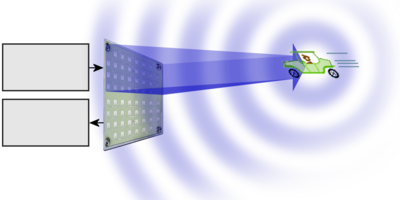
Back رادار الموجة المتصلة Arabic Radar d'ona contínua Catalan Dauerstrichradar German Radar de onda continua Spanish Radar à ondes entretenues French מכ"ם גל רציף HE Radar a onda continua Italian 周波数変調連続波レーダー Japanese Sürekli dalga radarı Turkish
Continuous-wave radar (CW radar) is a type of radar system where a known stable frequency continuous wave radio energy is transmitted and then received from any reflecting objects.[1] Individual objects can be detected using the Doppler effect, which causes the received signal to have a different frequency from the transmitted signal, allowing it to be detected by filtering out the transmitted frequency.
Doppler-analysis of radar returns can allow the filtering out of slow or non-moving objects, thus offering immunity to interference from large stationary objects and slow-moving clutter.[2][3] This makes it particularly useful for looking for objects against a background reflector, for instance, allowing a high-flying aircraft to look for aircraft flying at low altitudes against the background of the surface. Because the very strong reflection off the surface can be filtered out, the much smaller reflection from a target can still be seen.
CW radar systems are used at both ends of the range spectrum.
- Inexpensive radio-altimeters, proximity sensors and sports accessories that operate from a few dozen feet to several kilometres
- Costly early-warning CW angle track (CWAT) radar operating beyond 100 km for use with surface-to-air missile systems
- ^ "Continuous-wave Radar". Federation of American Scientists.
- ^ Srivastav, A.; Nguyen, P.; McConnell, M.; Loparo, K. N.; Mandal, S. (October 2020). "A Highly Digital Multiantenna Ground-Penetrating Radar System". IEEE Transactions on Instrumentation and Measurement. 69: 7422–7436. doi:10.1109/TIM.2020.2984415. S2CID 216338273.
- ^ "Continuous-wave Radar". Radartutorial.eu.
